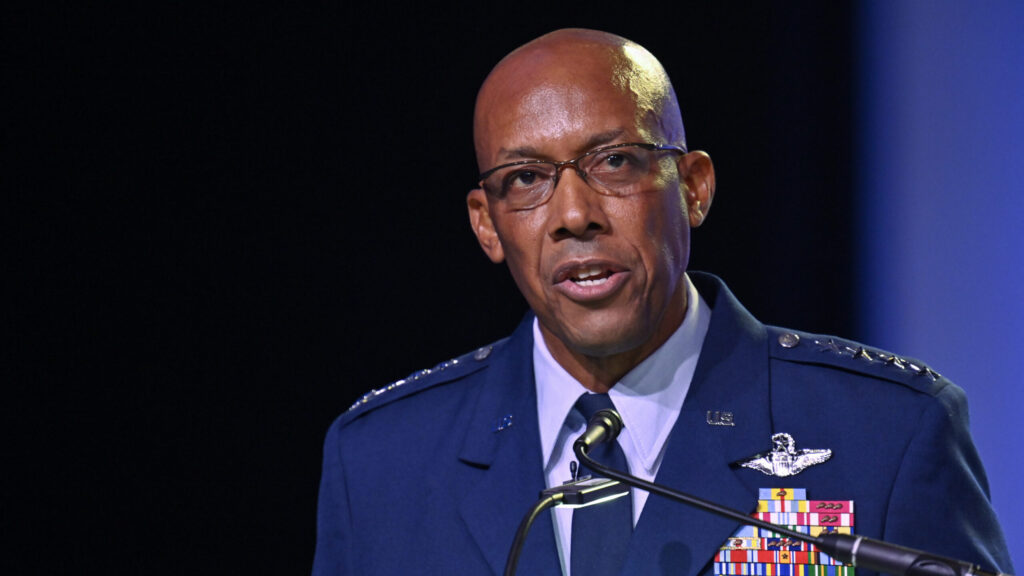
Air Force Chief of Staff Gen. CQ Brown, Jr. delivers his “Accelerate Change to Empowered Airmen” speech during the 2021 Air Force Association Air, Space and Cyber Conference in National Harbor, Md., Sept. 20, 2021. (US Air Force photo by Eric Dietrich)
WASHINGTON — The Air Force intends to lean into the use of uncrewed aircraft to fly alongside manned aircraft, including committing more funding for the cutting edge tech in future budgets, Chief of Staff Gen. CQ Brown said today.
“We’re getting down the path to to have much more capability for uncrewed aircraft,” he told an audience at the Brookings Institute today. “I think you’ll you’ll see as we start looking at our future budgets and the analysis we’re doing as part of the operational imperatives that we are committed to more uncrewed capability.”
Development of the Next Generation Air Dominance (NGAD) family of systems is one of Air Force Secretary Frank Kendall’s seven operational imperatives he says are needed to stay ahead of China, released this past March. The NGAD program includes the development of a sixth-generation fighter jet, along with a multifunctional set of semi-autonomous drones designed to accompany those piloted jets, known as Collaborative Combat Aircraft. The competition for those next-generation drones could begin in fiscal year 2024, Breaking Defense reported.
Brown reiterated that the advantages of using uncrewed aircraft are that it saves the service from having to buy expensive, single-mission piloted aircraft, as well as keeping an “actual crew” from harm’s way.
The plan is to have Collaborative Combat Aircraft fly “not just with the NGAD,” but also with fifth-generation fighters such as the F-35, he explained. This is requiring the service to think about the program in a new way as it develops a future investment strategy.
“As we look into our future budgets, there’s three aspects of this. There’s the platform itself, there’s the autonomy that goes with it, and then there’s how we organize, train and equip to build the organizations,” Brown said. “And we’re trying to do all those in parallel.”
That involves recognizing that the future drones should be capable of providing different functions, and that such aircraft would be paired with different types of piloted aircraft.
“It can be a sensor, it could be a shooter, it could be a jammer. But how does it team with a crewed aircraft and be operated from the back of a KC-46? And we’ll have E-7s eventually — could you operate it from the back of E7? Could you operate it from a fighter cockpit? And we’re thinking through those aspects.”
JADC2: All-In-One Kill Chain
In his wide ranging remarks, Brown also touched upon progress in the Defense Department’s efforts to implement Joint All Domain Command and Control (JADC2) across the services. The concept, he said, is actually quite simple — “to be able to get the data, put it into a cloud and then be able to access the data through applications and not do it service by service by service. So we don’t have an Air Force kill chain, or have a Navy kill chain, a Marine Corps kill chain, [and an] Army kill chain.”
The crux of JADC2, he added, answering the question of “how do you move that data around to determine who is the best to actually execute against a target or to use that information to be able to make a decision?”
And answering that question has been challenging to DoD and the services, he explained.
“The challenge we have as we start this transition is each of the services [has] invested in their various command and control systems, and how do you, then, align those,” Brown said. “The goal is not that I have to connect every airplane to every tank, for example, but how do I get my data off my airplanes to an area that if the ground commander or maritime commander needs that information, they can pull it.”
The “key point” is figuring out “some level of commonality in how we move data,” he said.
But Brown was adamant that the services are moving in tandem toward JADC2 substantiation.
“I will tell you we are we are making a lot more progress.” he said. “[W]hen I first came into this position, it was still kind of maybe PowerPoint deep, right? … [O]perationally we knew we wanted, but we didn’t have the deep thoughts on the architecture, the technical aspects of this.”
Progress has been possible, Brown explained, because the Air Force and other services have “spent a lot more time” together hashing things out, noting that he had a meeting last June with the other service chiefs the with the other services that while not resolving all the issues, but did “energize our staffs to start communicating.”
Brown explained that the approach outlined by Kendall is essentially for the Air Force to work with its sister services on a “basic building block” for JADC2 that then will allow each to customize to meets individual service needs.
“We’ve got pretty good alignment as we work with the other services to be able to do this,” he said.
Brown further noted that the Space Force will play a major role in making JADC2 work by providing the necessary connectivity for data sharing.
“A key part of this is going to be the space aspect of being able to move the data, which is why the Space Force is so important, to be able to layout that architecture,” he said.






















